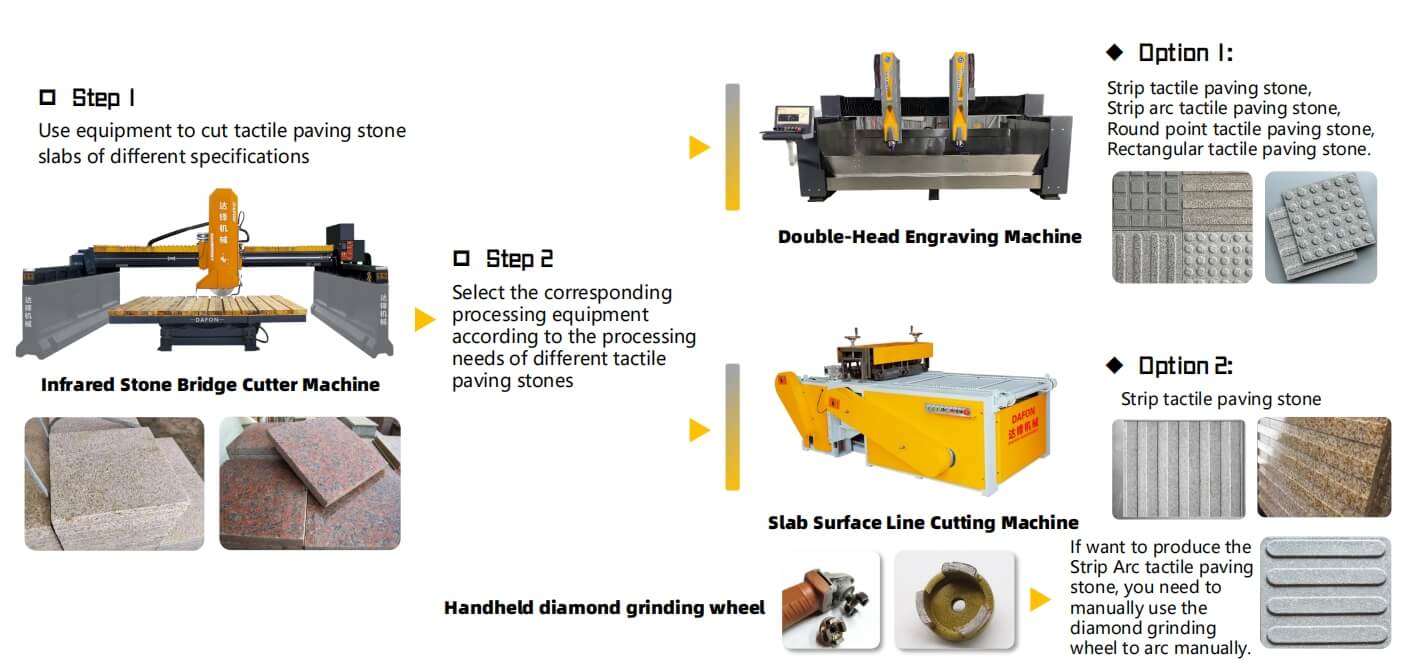Author:Dafon Kerbstone Machine FROM:Stone Machine Manufacturer TIME:2024-08-08
Tactile paving, also known as detectable warning surfaces or tactile ground surface indicators (TGSIs), is a system of textured ground surfaces designed to assist visually impaired pedestrians in navigating public spaces.
These surfaces are designed to help visually impaired individuals safely navigate public spaces by providing tactile feedback underfoot, typically installed on sidewalks, crosswalks, or public transportation platforms.
These surfaces provide tactile feedback through different patterns that can be felt underfoot or with a cane, allowing individuals with visual impairments to detect changes in their environment, such as approaching street crossings, platform edges, or other hazards.
There are generally two main types of tactile paving:
Blister Paving: Typically found at pedestrian crossings, this pattern features a series of raised, rounded domes that indicate the presence of a crossing point.
Corduroy or Line Paving: This pattern consists of raised, parallel bars and is often used to indicate hazards such as stairs, ramps, or platform edges at train stations.
Tactile paving is an essential element in creating accessible environments, helping to ensure that public spaces are navigable and safe for everyone, including those with visual impairments.
Yes, tactile paving is highly useful, especially for individuals with visual impairments. Its benefits include:
Enhanced Safety: Tactile paving helps visually impaired people detect potential hazards like platform edges, stairs, or street crossings. The tactile feedback provided by the raised patterns helps them navigate safely in public spaces.
Improved Independence: By providing clear, tactile cues, tactile paving enables people with visual impairments to move more independently without relying as much on sighted guides or assistance.
Increased Accessibility: Tactile paving is an important aspect of inclusive design, ensuring that public spaces, transportation systems, and urban environments are accessible to everyone, regardless of their level of vision.
Universal Design: While tactile paving is designed primarily for those with visual impairments, it can also be helpful for others, such as elderly people or those with cognitive impairments, who may benefit from additional environmental cues.
Overall, tactile paving is a crucial feature in promoting safety, accessibility, and independence for all individuals in public spaces.
1. Materials
The main stone materials of tactile paving stones are sesame grey, sesame white, general red, sesame black, Lu grey, and other granite stones. As granite has a dense structure, high compressive strength, strong hardness, good water resistance, and wear resistance, etc., which can ensure the durability of tactile paving stones.
2. Classification
The tactile paving stone is mainly for the blind to provide walking convenience and safety of road facilities, generally paved by two types of bricks, one is the strip guide tiles, which guide the blind to move forward; One type is a tip tile with dots, indicating that there is an obstacle in front of the blind and it is time to turn.
3. Processing
Option 1:
Strip tactile paving stone,
Strip arc tactile paving stone,
Round point tactile paving stone,
Rectangular tactile paving stone.
Step 1
Use equipment to cut tactile paving stone
slabs of different specifications
Step 2
Select the corresponding processing equipment according to the processing needs of different tactile paving stones

Option 2:
Strip tactile paving stone If want to produce the Strip Arc tactile paving stone, you need to manually use the diamond grinding wheel to arc.